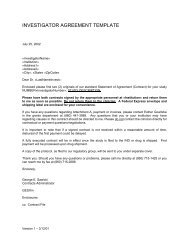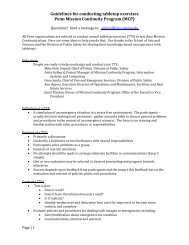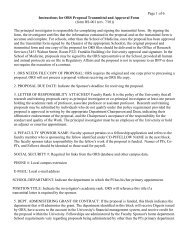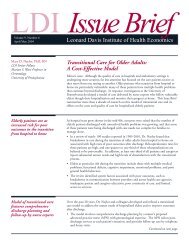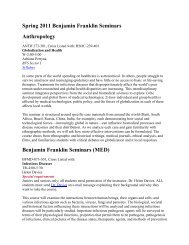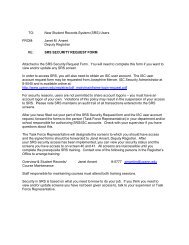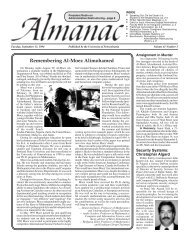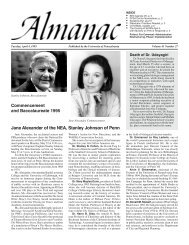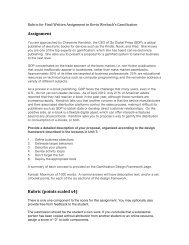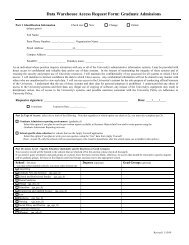No. 5 September 24, 1991 - University of Pennsylvania
No. 5 September 24, 1991 - University of Pennsylvania
No. 5 September 24, 1991 - University of Pennsylvania
Create successful ePaper yourself
Turn your PDF publications into a flip-book with our unique Google optimized e-Paper software.
On October 9 at Dunlop Auditorium, 3-4:20 p.m,. a panel <strong>of</strong> leading Penn scientists will discuss ethical conduct in research [see under<br />
Talks in October at Penn for details]. The discussion, open to all members <strong>of</strong> the <strong>University</strong> community, coincides with the production <strong>of</strong><br />
Handbook on Ethical Conduct in Biomedical Research now being provided to biomedical graduate students.<br />
Below, published by permission, are excerpts from the new Handbook.<br />
From the Foreword by Dr. Saul Winegrad, Director <strong>of</strong> Biomedical Graduate Studies: In the last several years considerable attention<br />
has been given to a small number <strong>of</strong> incidents in which there have been major violations <strong>of</strong> the generally accepted but uncodified philosophy <strong>of</strong><br />
the ethical conduct <strong>of</strong> research. These incidents, which have involved a small fraction <strong>of</strong> one percent <strong>of</strong> the pr<strong>of</strong>essionals engaged in biomedical<br />
research, have led to an examination <strong>of</strong> methods for the conduct <strong>of</strong> research by agencies <strong>of</strong> the government, by the scientific community, and by<br />
the media. Scientists in particular have begun to address the complexities <strong>of</strong> research with particular focus on the issues <strong>of</strong> honesty, bias, credit,<br />
responsibility, and attribution. The efforts so far have not led to exposure <strong>of</strong> any sizable number <strong>of</strong> episodes <strong>of</strong> fraud or conscious attempt to<br />
deceive, but they have begun to make investigators more aware <strong>of</strong> certain problems including subjectivity, unconscious bias, and attribution <strong>of</strong><br />
responsibility as well as credit, that appear to be inherent in the conduct <strong>of</strong> research. These problems cannot be totally eliminated for they are a<br />
product <strong>of</strong> the fallibility <strong>of</strong> human beings, but they can be recognized, openly acknowledged, and constructively addressed by discussion among<br />
scientists and with trainees. The consequences <strong>of</strong> these problems can be sharply reduced by good habits <strong>of</strong> research as should be exercised in the<br />
design and execution <strong>of</strong> the experiments and analysis <strong>of</strong> data. Education <strong>of</strong> this nature is the major goal <strong>of</strong> the program in the Ethical Conduct <strong>of</strong><br />
Biomedical Research.<br />
The contents <strong>of</strong> [Penn’s] handbook are meant to serve as a guide in discussing matters concerned with the proper conduct <strong>of</strong> research. Material<br />
has been assembled to identify important aspects <strong>of</strong> this pursuit. In doing so, it has been judged appropriate to include not only material<br />
dealing with the execution <strong>of</strong> research but also with the contributions <strong>of</strong> the government, the legal community, and the scientific administrative<br />
community to this topic.<br />
A trainee in biomedical research should be taught to maintain the highest standards <strong>of</strong> scientific integrity and ethical behavior in all phases <strong>of</strong><br />
the conduct <strong>of</strong> research. Equally important for a trainee is the realization that scientific data collected with the greatest care and ethical considerations<br />
may contain errors unrecognized at the time because <strong>of</strong> the limitations <strong>of</strong> knowledge or technology. Interpretation <strong>of</strong> results represents<br />
the best thinking <strong>of</strong> only a small number <strong>of</strong> investigators at a particular point in time. These limitations are inherent in the conduct <strong>of</strong> research<br />
and the generation <strong>of</strong> new information. In an open scientific community exercising healthy skepticism and with freedom to discuss, dispute, and<br />
disagree, the errors will be recognized and corrected as the research and the scientific literature evolve.<br />
From the Handbook: Ethics <strong>of</strong> Biomedical Research at the <strong>University</strong> <strong>of</strong> <strong>Pennsylvania</strong><br />
A. Defining Ethics and Scientific Misconduct<br />
At the most basic level, scientific ethics relates to trust, as trust in prior<br />
research is an essential component in scientific advancement. Scientific<br />
trust relates to honesty in experimental conception and design, and in the<br />
recording, evaluation, and reporting <strong>of</strong> data. Misconduct can occur at any<br />
stage from the inception <strong>of</strong> an idea to the reporting <strong>of</strong> results. Misconduct<br />
is defined as fabrication, falsification, plagiarism, or other practices that<br />
deviate from accepted standards <strong>of</strong> observing, conducting, or reporting<br />
<strong>of</strong> research. Misconduct is distinguished from fraud, which is criminal<br />
in its intent. For example, plagiarism is fraud, while consistently poor<br />
experimental design is misconduct. Since misconduct is not defined in<br />
the criminal sense, the definition <strong>of</strong> “burden <strong>of</strong> evidence” as opposed to<br />
“beyond a reasonable doubt” is applied.<br />
B. The Incidence <strong>of</strong> Misconduct<br />
Misconduct has always occurred in science. Examples abound, including<br />
the notebooks <strong>of</strong> famous and respected scientists such as Mendel and<br />
Millikan. Is there more misconduct today? We can’t say absolutely, but<br />
there is little question that it is a serious problem. The unproven perception<br />
is that misconduct is on the rise due to increased pressures on scientists<br />
for job security and funding. The motivation for misconduct is, however,<br />
not always obvious, and <strong>of</strong>ten appears in the form <strong>of</strong> a drifting <strong>of</strong> the<br />
perceived ethical norms. The Office <strong>of</strong> Scientific Integrity (OSI/NIH),<br />
which was established in 1990 to oversee management <strong>of</strong> investigations,<br />
handled 80 investigations <strong>of</strong> alleged misconduct in its first 15 months.<br />
These ranged from cases <strong>of</strong> repeatedly misquoted references, to plagiarism<br />
<strong>of</strong> the written word, to manipulation or fabrication <strong>of</strong> data. There was no<br />
evidence <strong>of</strong> misconduct in 75% <strong>of</strong> these cases. Thus, 20 cases yielded<br />
convictions from a total <strong>of</strong> over <strong>24</strong>,000 grants funded by NIH during<br />
this period. One might also question the ethical standards <strong>of</strong> students. A<br />
recent national survey showed that 12% <strong>of</strong> students in postgraduate level<br />
training programs admitted to personal misconduct at some level: 12%<br />
reported they would engage in misconduct to publish data; 10% reported<br />
firsthand knowledge <strong>of</strong> fabrication in the research <strong>of</strong> others. The most<br />
common form <strong>of</strong> misconduct was manipulation <strong>of</strong> data, e.g., leaving out<br />
data points. Thirty percent reported knowledge <strong>of</strong> inappropriate authorship<br />
or plagiarism.<br />
C. Organization <strong>of</strong> the Instructional Program at Penn<br />
The philosophy <strong>of</strong> the <strong>University</strong> <strong>of</strong> <strong>Pennsylvania</strong> as it pertains to<br />
research ethics and postgraduate training is first to establish an awareness<br />
<strong>of</strong> the most basic principles <strong>of</strong> scientific ethics, and then to provide a<br />
practical framework for the maturation <strong>of</strong> high ethical standards. The<br />
instructional program at Penn employs a combination <strong>of</strong> approaches<br />
that focus on three main areas: (1) instruction in ethics and morality;<br />
(2) instruction in data collection, management, and reporting and; (3)<br />
case studies <strong>of</strong> scientific misconduct<br />
Ethics and Morality: Whether ethical behavior can be taught remains<br />
open to question. However, we can help students develop an appreciation<br />
<strong>of</strong> what constitutes ethical behavior in particular situations. At best,<br />
however, this is only fine tuning, as ethical behavior is established quite<br />
early by role models. So called “morality-reasoning tests” show that the<br />
concepts <strong>of</strong> morality deepen with age for the first thirty years and then<br />
level <strong>of</strong>f. Instruction in ethical behavior is best handled by a combination<br />
<strong>of</strong> philosophers and historians with expertise in both ethics and scientific<br />
history and methodology. This interdisciplinary approach should create an<br />
appropriate framework for defining basic ethical standards, the relationship<br />
<strong>of</strong> these standards to ethical behavior, the unique role <strong>of</strong> scientists<br />
in today’s society, and the pressures within the scientific community that<br />
influence ethical behavior.<br />
An illustration <strong>of</strong> ethical behavior is only relevant in the context <strong>of</strong> the<br />
moral environment. To assist the development <strong>of</strong> ethical conduct we must<br />
also try to reduce the pressures that influence misconduct. This could be<br />
accomplished by evaluating students and faculty on the basis <strong>of</strong> scientific<br />
quality and insight, in addition to the more standard and easy<br />
benchmarks <strong>of</strong> publication number and funding level. This is more easily<br />
accomplished for the progression <strong>of</strong> students. In particular, thesis committees<br />
should be interactive, and thesis committee meetings should be<br />
examples <strong>of</strong> scientific discourse, not formal presentations intended largely<br />
to convince.<br />
Instruction in Proper Data Management: Many instances <strong>of</strong> misconduct,<br />
as defined and reported by OSI/NIH, reflect improper training<br />
in data analysis and interpretation. The distinction to be made here is one<br />
<strong>of</strong> unconscious bias. These errors are not evaluated by morality tests, and<br />
instruction in these areas should be a great benefit. Instruction should<br />
include all areas <strong>of</strong> data management. These areas include: experimental<br />
design, collecting data, and reporting findings. This should not be a review<br />
<strong>of</strong> statistical methods; rather, the rationale for application <strong>of</strong> statistical<br />
methods should be emphasized.<br />
Use <strong>of</strong> Case Studies:This is one <strong>of</strong> the most beneficial areas. A collection<br />
<strong>of</strong> case studies are available that range in severity and intent from<br />
unintentional neglect to malicious plagiarism or fraud. These should be<br />
read and discussed in small groups. The discussion should focus on the<br />
nature <strong>of</strong> the misconduct, the reasons for the misconduct, and ways to<br />
avoid misconduct.<br />
Almanac Ed. <strong>No</strong>te: The above is a portion <strong>of</strong> the Handbook’s Section II.<br />
Other sections give historical information, case studies, and definitions and<br />
interpretations <strong>of</strong> misconduct and <strong>of</strong> due process as seen by the research<br />
community and major funding agencies.<br />
ALMANAC <strong>September</strong> <strong>24</strong>, <strong>1991</strong>




